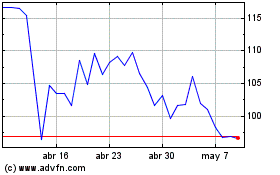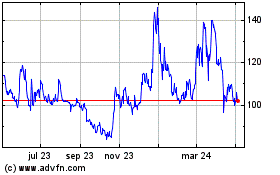Bitcoin Price Breaks Past $51,500: 4 Key Reasons
14 Febrero 2024 - 4:00AM
NEWSBTC
On Tuesday, the Bitcoin price plunged from $49,900 to $48,300
following the release of the US inflation data. As NewsBTC
reported, the data came in hotter than expected. Instead of 2.9%,
headline CPI came in at 3.1%, while the core CPI was even at 3.9%
instead of the expected 3.7%. The traditional financial market
reacted negatively and dragged Bitcoin down with it, as
expectations for interest rate cuts have shifted further into the
future. The prediction markets are now pricing in only 4 rate cuts
in 2024 after CPI inflation reached 3.1% in January. This is a huge
drop in expectations as just over a month ago the markets were
still pricing in 6 rate cuts. The Fed’s most recent forecast was
for 3 rate cuts in 2024. The probability of a rate cut in March is
below 10% and the probability of a rate cut in May is falling
rapidly. In contrast to the S&P 500, however, the Bitcoin price
showed a strong reaction and quickly rose again to $49,900. The
reaction of the Bitcoin market is quite telling for the short-term
future. And the Bitcoin price is showing just that today. At
press time, BTC rose above $51,500, marking a new yearly high. Here
are 4 key reasons: #1 Record-Breaking Bitcoin ETF Inflows The surge
in Bitcoin ETF inflows marks a pivotal moment for Bitcoin,
reflecting a significant shift in investor sentiment and market
dynamics. On a record-breaking day on Tuesday, the net inflows into
spot Bitcoin ETFs reached $631 million, led by The Nine with an
inflow of $704 million, signaling a substantial accumulation of
Bitcoin. Key players like Blackrock and Fidelity played a
significant role in this influx, with Blackrock experiencing nearly
half a billion dollars ($493 million) in inflows and Fidelity $164
million. The overall net inflow of $2.07 billion over four trading
days, averaging over half a billion per day, highlights the
staggering sustained demand for Bitcoin. Related Reading:
Inflationary Concerns Rise As US CPI Exceeds Predictions, Bitcoin
Price Reacts This demand is notably new capital, as GBTC outflows
remained stable at $73 million, indicating these inflows are not
merely a rotation from GBTC but represent fresh investments. Matt
Hougan, CIO of Bitwise emphasized the significance of this
movement: IMHO the [numbers] undercounts the fundamental new
investor demand for these ETFs. People assume all of the money
flowing out of GBTC to date is rotating into other bitcoin ETFs.
But a good chunk of it is from inorganic holders […] Long-term
investors have backfilled that and added $3b more on top. I suspect
the real new investor-led new demand is north of $5b, and shows no
signs of slowing. #2 Genesis GBTC Liquidation Concerns Alleviated
Fears of a Bitcoin crash, similar to FTX’s sale of GBTC, triggered
by Genesis’ planned liquidation of Grayscale Bitcoin Trust (GBTC)
shares have been alleviated, as reported today on Bitcoinist. The
liquidation, necessary due to Genesis’ bankruptcy, was initially
viewed as a potential market downturn catalyst. The bankrupt lender
needs to liquidate approximately 36 million shares of GBTC, valued
at around $1.5 billion, as part of its strategy to resolve
financial challenges stemming from significant loans and regulatory
settlements. Related Reading: Bitcoin Continues To Break Wall
Street Records: The Whales Are Here However, the proposed Chapter
11 settlement involves in-kind repayments to creditors, reducing
direct selling pressure on Bitcoin. This strategy aligns with the
interests of long-term Bitcoin holders, potentially limiting market
volatility. Greg Schvey, CEO at Axoni, highlighted: The proposed Ch
11 settlement requires Genesis to repay creditors in kind (i.e.
bitcoin lenders receive bitcoin in return, rather than USD). […]
Notably, in-kind distribution was a priority negotiation topic to
prevent long-term BTC holders from recognizing gains when receiving
USD back (i.e. a forced sale). This would seem to indicate a
substantial volume of lenders don’t plan to sell immediately. #3
OTC Demand Exceeds Supply The statement by CryptoQuant CEO Ki Young
Ju that “Bitcoin demand exceeds supply at OTC desks currently” is a
significant indicator of underlying market strength. OTC
transactions, preferred by large institutional investors for their
discretion and minimal market impact, are reflecting a robust
demand for Bitcoin. This demand-supply imbalance at OTC desks
suggests that large players are accumulating Bitcoin, a bullish
signal for the cryptocurrency’s price outlook. #4 Futures And Spot
Market Dynamics The analysis of futures and spot market indicators
by @CredibleCrypto sheds light on the technical factors signaling a
bullish continuation for Bitcoin. The analyst points out, “Data
supporting the idea that that was ‘the dip’. – OI reset back to
levels before the last pump – Funding decreasing through this local
consolidation – Spot premium is back.” These observations suggested
a healthy market correction rather than the start of a bearish
trend, with the reset in open interest and the decrease in funding
rates indicating that the market has absorbed the shock and is
primed for upward movement. In conclusion, The combination of
record ETF inflows, alleviated concerns over Genesis’ GBTC
liquidation, strong OTC demand, and favorable futures and spot
market dynamics provides a compelling case for Bitcoin’s potential
rally. Each of these factors, supported by expert insights and
market data, underscores a growing investor confidence. Featured
image created with DALL·E, chart from TradingView.com
Quant (COIN:QNTUSD)
Gráfica de Acción Histórica
De Mar 2024 a Abr 2024

Quant (COIN:QNTUSD)
Gráfica de Acción Histórica
De Abr 2023 a Abr 2024
